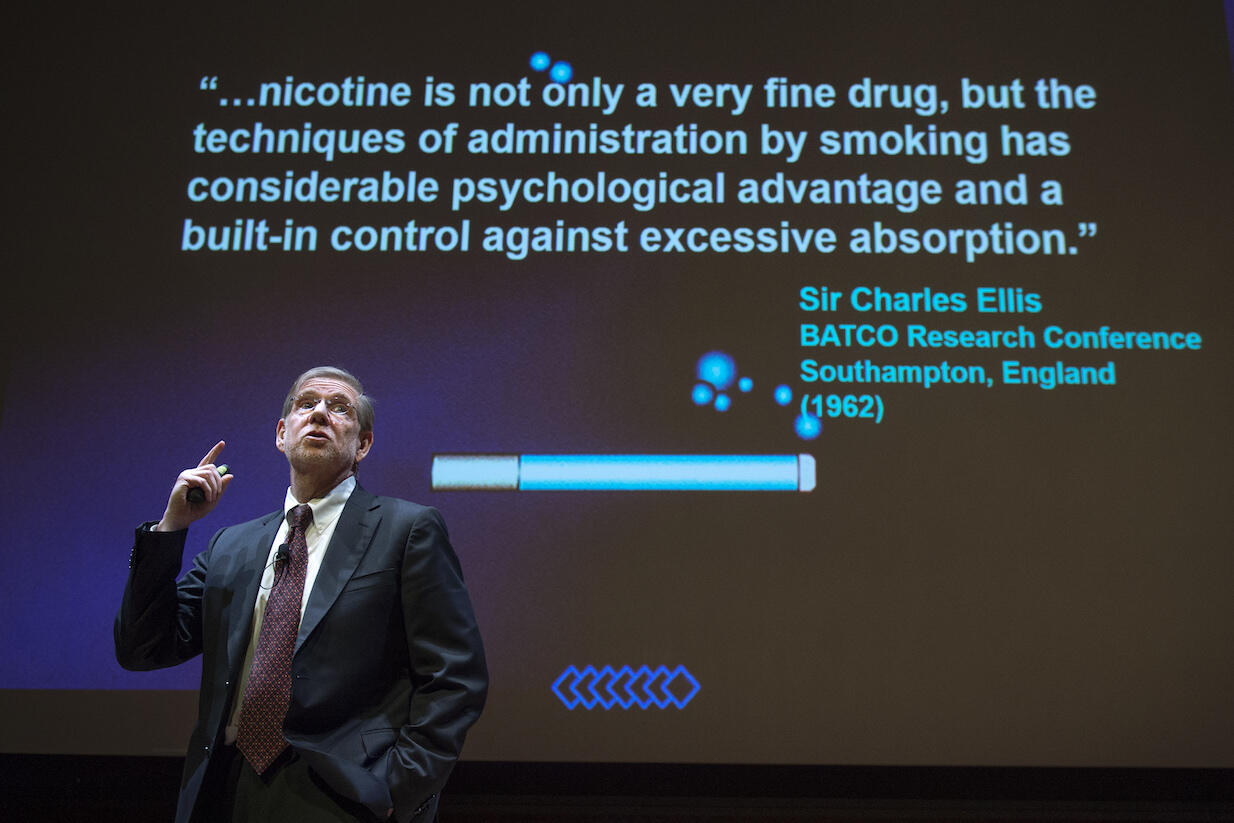
Nov. 13, 2019
Former FDA head: Lessons from ‘Tobacco Wars’ are a primer on how to regulate e-cigarettes
Share this story
How did regulatory agencies challenge Big Tobacco in the 1990s and how can lessons from that time be applied to current dangers presented by e-cigarettes? David Kessler, M.D., former commissioner of the U.S. Food and Drug Administration, says it started with good detective work.
Speaking at Virginia Commonwealth University on Monday, Kessler told a crowd of students, faculty, staff and members of the public that gumshoe and research were key to proving harm and advocating for greater regulation of nicotine and the tobacco industry during his time at the FDA from 1990-97.
In an interactive presentation on the “Tobacco Wars,” Kessler put the audience in his shoes and asked them to explain how they would go about building an argument that influential tobacco companies with deep pockets were harming the public with nicotine products, all while presenting an image for decades that smoking was cool and liberating.
“What money are we talking about? What money is there? How does it work? Where does that money go?” Kessler asked the crowd as the audience unpacked links between agency allocations and political support.
As FDA commissioner, Kessler oversaw the agency’s implementation of the Nutrition Labeling and Education Act, which required the placement of nutritional information on packaged food. He is the author of “A Question of Intent: A Great American Battle with a Deadly Industry,” which chronicles his tenure at the FDA and its battles against the tobacco industry.
On Monday, he asked students in the audience how they would build evidence to show nicotine’s harm and show how tobacco companies were intentionally adding nicotine to their products even while they purported to lower tar content.
“Why does the lightest cigarette have the highest concentration of nicotine? How does that work?” Kessler asked.
The answer, he said, was in the very public information found in patents that tobacco companies were filing to raise tobacco and nicotine content in cigarettes. Investigators at Southern ports spotted numerous half-million pound shipments of imported tobacco with raised nicotine through a dragnet, he said.
“So, what evidence do we have of intent?” Kessler asked the crowd, walking them through his process as he attempted to achieve FDA regulation of tobacco. “So far, we have patents. We have light cigarettes having the highest concentration of nicotine. Right?”
But one of the biggest challenges to controls and regulations would prove to be public perception of cigarettes and tobacco as dangerous, Kessler said. The products were often marketed to women and young teens.
Kessler admitted to mistakes and bumps along the way to building up strong evidence documenting nicotine’s addictive and harmful effects. In his tenure, restrictions were placed on the advertising and sale of tobacco. The “Tobacco Wars” ultimately resulted in FDA v. Brown & Williamson Tobacco Corp., a March 2000 Supreme Court case in which the court ruled that the FDA did not have the power to regulate tobacco products as “drugs” or “devices.” That decision was overridden by the 2009 passage of the Family Smoking Prevention and Tobacco Control Act, which gave the FDA the authority to regulate the tobacco industry and control the level of nicotine in cigarettes.
Monday’s event was presented by the Center for the Study of Tobacco Products and the Department of Psychology in the College of Humanities and Sciences. The center, home to a multidisciplinary team studying the regulation of tobacco products, received a $19.78 million grant in 2018 to launch a five-year project on predicting outcomes of government regulations of tobacco products, including e-cigarettes.
Kessler connected with Thomas Eissenberg, Ph.D., director of the center and a professor in the Department of Psychology, in the summer to learn more about vaping products and what makes them so successful in attracting young people. Eissenberg’s primary area of research involves developing and demonstrating methods to evaluate modified risk of tobacco and nicotine products. His classes read Kessler’s book, “A Question of Intent.”
Kessler, who was elected chair of the board of directors of the Center for Science in the Public Interest in June, ended his talk at VCU by directing his attention to issues and hurdles relating to the FDA's attempt to regulate current tobacco products, including e-cigarettes.
His visit provided students with a regulator’s viewpoint of how science factors into regulation, Eissenberg said.
“I wanted students to get a regulator's viewpoint. It would help them a lot to understand how their science is being used at a regulatory level,” Eissenberg said. “And what I hope is we're not going to allow similar activities, manipulation of nicotine levels, increased addictiveness to happen in the future with electronic cigarettes and whatever other novel tobacco products the companies come up with.”
Subscribe to VCU News
Subscribe to VCU News at newsletter.vcu.edu and receive a selection of stories, videos, photos, news clips and event listings in your inbox.










